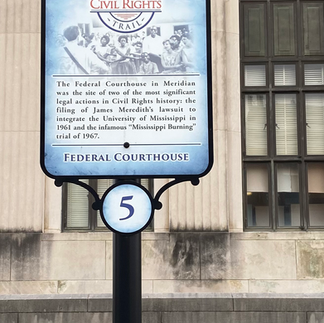Meridian to Philadelphia
- kochba2314
- Nov 20, 2022
- 4 min read
Updated: Aug 14, 2023
One definition of meridian is, " a point or period of highest development, greatest prosperity, or the like." and Philadelphia is a combination of the greek works love(platonic) and brother. When William Penn founded Philadelphia, PA it was with the vision that it would be a city of religious tolerance where no one would be persecuted. Cut to Meridian and Philadelphia, MS and you find one of the most intolerant and lowest point
s in American history. But let's start earlier than that.

Prior to Europeans coming to this area, the Choctaw nation resided here. As the population of non-natives was growing the Choctaw found their lands shrinking. In 1830, they signed the Treaty of Dancing Rabbit Creek and agreed to move westward. Establish in 1860, the city of Meridian became a bustling transit center as it was a key stop on the railroad from New Orleans to Ohio.
In 1858, Richard McLemore, gave 160 acres to his daughter Juriah and her husband. They built a small greek revival cottage, Merrehope. In 1863, Confederate General Leonidas Polk moved his family into the home and used it as his headquarters and billeting for some of his staff. General Sherman arrived in 1864, and he burned the city, blew up ammunition's depot and trashed the railroad. His soldier did what came to be known as "bow ties." They burned the wooden rail road ties and when the fire got hot enough, they put in the metal rails and twisted them so as to be unusable.
It is thought that Merrehope survived because it was Polk's residence; it is only one of six buildings that Sherman did not destroy as he claimed he had made Meridian to cease to exist. The residents were not harmed, and within 26 days, they had resourcefully fixed the railroad and started to rebuild their city. The owners of Merrehope added the grand front to the house that you see today. Eventually, it was given to an organization for preservation.
They have an uphill battle as the surrounding area is desperately poor which doesn't make if a welcoming location, nor do they seem to be interested in outside help. The sign said it was open, and I rang the bell but no one came. Finally, as I started to walk away someone opened a side door and let me in. Two men and a woman were conversing and I thought they would break up and someone would give me a tour or a brochure or something. Nope. They just kept talking and let me wander around the house.
A black man was sweeping the stairs and I had a brief conversation with him. Later I heard the woman tell him what a great job he was doing like he was a third grade student. Upstairs, I could see more water damage in addition to what i could see outside. They were preparing for their festival of trees and fake trees were in every room. Most of the decorations seemed gaudy and cheap. Let's just put it this way, it wasn't Longwood Gardens quality festival of trees. As I drove away, I processed their Minnesota like passive aggressiveness and lack of interest in "someone who wasn't from around here." Good luck getting enough money to keep that house going with that attitude.
Like in Tulsa, there was a race going on through town, a half and full marathon, so streets were blocked off and it made navigating a bit tricky. I did find the amazing Threefoot hotel which is an art deco masterpiece with a Starbucks on the ground floor.
Meridian is also home to the federal courthouse where two major civil rights events took place. First, James Meredith filed a discrimination lawsuit because even after the 1960 desegregation laws, he was denied admission to Mississippi University. He successfully entered in 1962 and became a life long civil rights activist.
It is also where the "Mississippi Burning" trial was held. Since the state had refused to press charges, the federal government did and 17 white men were tried for the three murders of Schwerner, Goodman, and Chaney. Only seven were convicted and received light sentences. But it was the first time anyone had been convicted on civil rights charges.
This is the jail where the trio were held for "speeding" and then released at 10 p.m. which was a dangerous time to be on the road in Mississippi in 1964. As I stood there, I wondered how the men felt when they were released. Did they think they would go free or did they anticipate further trouble?
I also found the marker for the approximate areas were the three were killed. Even now it is a remote area; it must have been much more so in 1964.

My next stop to complete the Freedom Summer sites was Mt Zion United Methodist Church. This is where the trouble started for Schwerner, Chaney and Goodman because they planned to use the church for a Freedom school. When the KKK got wind of that, they burned down the school and beat the pastors. The three men went to investigate and on the way back to Philadelphia were pulled over and jailed. People clearly still remember and honor their memory as there were plastic flowers on several markers.
Philadelphia was a nice little town. Beautiful homes in the historic district and cute shops downtown. I happened on one that carried locally made items so that was a score! I also took some time out for a bike ride at a park and campground near the Okatibbe dam. There were a fair amount of RV campers and one intrepid tent camper. i scronged some lunch at a local Mexican place where again I warned about the heat in the Shrimp Diabla but ordered it anyway! It was not that hot.


























































Comments